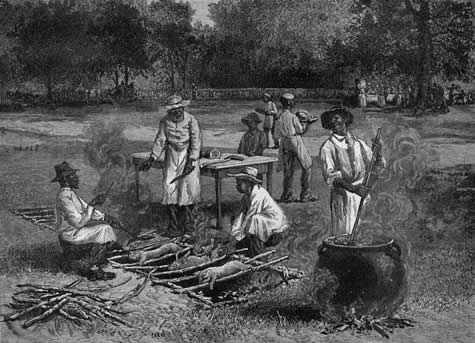The History of Barbeque
Barbecue or barbeque (common spelling variant) (with abbreviations BBQ, Bar-B-Q and Bar-B-Que; diminutive form of barbie) is a method and apparatus for cooking meat, with the heat and hot gases of a fire, smoking wood, or hot coals of charcoal or a propane gas grill, and may include application of a marinade, spice rub, or basting sauce to the meat. The term as a noun can refer to the meat, the cooking apparatus itself, or to a party that includes such food. The term as an adjective can refer to foods cooked by this method. The term is also used as a verb for the act of cooking food in this manner. Barbecue is usually cooked in an outdoor environment heated by the smoke of wood or charcoal.
Barbecue has numerous regional variations in many parts of the world. Notably, in the Southern United States, practitioners consider barbecue to include only indirect methods of cooking over hardwood smoke, with the more direct methods to be called "grilling".
Grilling refers to a fast process over high heat, while barbecuing refers to a slow process using indirect heat and/or hot smoke (very similar to some forms of roasting). For example, in a typical U.S. home grill, food is cooked on a grate directly over hot charcoal, while in a U.S. barbecue, the coals are dispersed to the sides or at significant distance from the grate.
Alternatively, an apparatus called a smoker with a separate fire box may be used. Hot smoke is drawn past the meat by convection for very slow cooking. This is essentially how barbecue is cooked in most U.S. "barbecue" restaurants, but nevertheless, many consider this to be a distinct cooking process called hot smoking.
The slower methods of cooking break down the collagen in meat and tenderizes the tougher cuts for easier eating.
In the southern United States, barbecue initially revolved around the cooking of pork. During the 19th century, pigs were a low-maintenance food source that could be released to forage for themselves in forests and woodlands. When food or meat supplies were low, these semi-wild pigs could then be caught and eaten.

It was the Spanish who first introduced the pig into the Americas and to the American Indians. The Indians, in turn, introduced the Spanish to the concept of true slow cooking with smoke. So, in that first fateful coming together, way back in the 1500s, the Spanish supplied the pig and the Indians showed them how to cook it. The Spanish colonists came to South Carolina in the early 1500's and they named their colony Santa Elena. It was established in the area now called Port Royal in Beaufort County. That colony lasted almost 20 years and it boasted a fort with several cannons, a church, a bakery, blacksmith foundry and shop, a pottery kiln and nearly 500 colonists including over 100 families. It was in that first American colony that the white man first learned to prepare and to eat real barbeque. So, people were eating barbeque in South Carolina even before that name had been applied to the area by the English.
According to estimates, prior to the American Civil War, Southerners ate around five pounds of pork for every one pound of beef they consumed. Because of the poverty of the southern United States at this time, every part of the pig was eaten immediately or saved for later (including the ears, feet, and other organs). Because of the effort to capture and cook these wild hogs, "pig slaughtering became a time for celebration, and the neighborhood would be invited to share in the largesse. The traditional Southern barbecue grew out of these gatherings."
